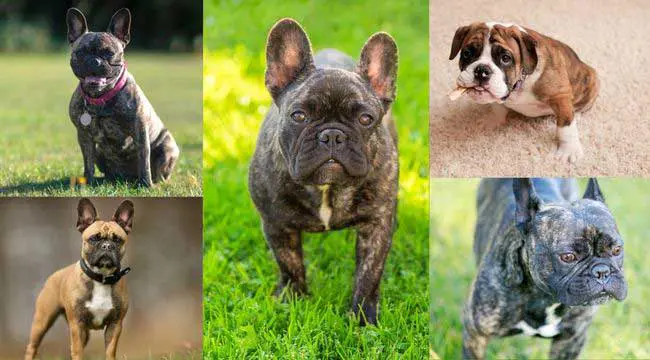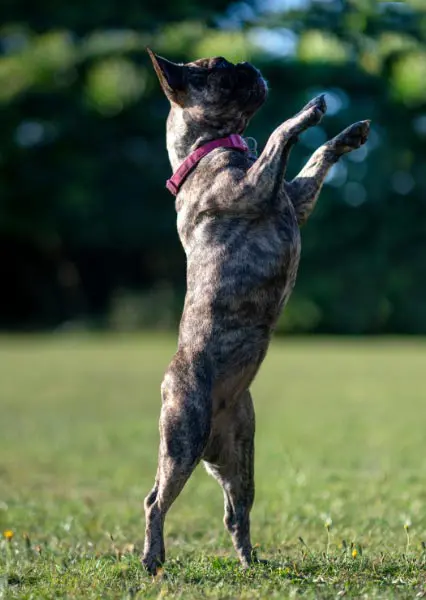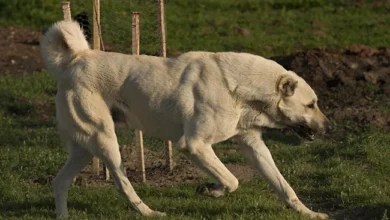
Brindle French Bulldogs are undeniably captivating with their stunning looks and unique coat patterns. If you’ve ever encountered a Brindle Frenchie, you’ll immediately recognize them by the light streaks that crisscross their dark base coat.
The brindle pattern typically displays a lovely light shade of fawn, while the base coat can come in various colors, including standard black, as well as blue, chocolate, and lilac. Depending on the mix of dark and fawn hairs, these charming pups can range from very dark to quite light in appearance.
Sporting a black nose and dark eyes, Brindle French Bulldogs exude undeniable charm. Interestingly, brindle is not only the oldest but also the most common pattern found in this breed. It’s no wonder that kennel clubs readily accept it, alongside fawn, white, and pied, while other colors like blue, chocolate, and lilac are less recognized.
So, if you aspire to compete in dog shows with your furry friend one day, a black brindle Frenchie might be the perfect choice for you! Get ready to explore the distinctive elegance and allure of the Brindle French Bulldog as we delve into their origins, physical traits, and delightful personalities.
This blog post will cover everything you need to know about Brindle French Bulldogs, from their grooming needs to their personality traits. We’ll also provide some helpful tips for taking care of your new furry friend. So sit back, relax, and enjoy learning about these special dogs!
Table of Contents
- What Is a Brindle French Bulldog?
- Brindle French Bulldogs History
- Different Colored Brindle Frenchie
- The Secret of Brindle Color
- Brindle French Bulldogs size
- Brindle French Bulldogs Temperament
- Brindle French Bulldogs Grooming
- Brindle French Bulldogs Training
- Brindle French Bulldogs Exercise
- Brindle French Bulldogs Diet
- Brindle French Bulldogs Health
- How Long Do French Bulldogs Live?
- Are Brindle Frenchies Rare?
What Is a Brindle French Bulldog?
The French bulldog is a surprisingly diverse breed, with a rich history of various colors and patterns. Among these, one of the most visually striking is the brindle coat, celebrated for its spectacular markings. Originally, this distinctive pattern was primarily seen in French hunting dogs. However, it crossed the Atlantic around 1680 when Prince William III assumed power, bringing this unique breed feature to a broader audience.
Brindle French Bulldogs are easily recognizable by their stunning black and white design, which stands in stark contrast to the typical brown or cream fur coats seen in other Frenchies. The defining characteristic of these dogs is the twisting stripes that adorn their bodies, creating varying degrees of darkness in certain areas and the occasional appearance of lighter spots.
In fact, many enthusiasts fondly refer to them as ‘tiger-striped’ due to the resemblance. These French Bulldogs stand out from their counterparts due to their distinctive light and dark stripes. Their unique appearance has made them a beloved choice for pet owners and enthusiasts alike.
Brindle French Bulldogs History
In 1835, when blood sports went bust in Britain, Bulldog breeders found a new source of income by breeding dogs for exhibition. “Toy Bulldogs” were distinguished at these shows as small Bulldogs. This breed of smaller dogs migrated to France during the industrial revolution, where their popularity continued to grow. We found the first photo of a brindle Frenchie in 1901, although they had certainly been around for a long time before that.
Different Colored Brindle Frenchie
Brindle Frenchies are a type of French bulldog with a dark coat and lighter coat color patterns. The Agouti gene and the K-Locus gene are responsible for the Brindle hue. Brindle Frenchies come in various colors and patterns, including Seal, Blue, Tiger, Pied, and Reversed.

Brindle French Bulldogs
A brindle French Bulldog boasts a captivating coat pattern composed of random spots and stripes on their base color coat. This pattern mixes any dark French Bulldog color with lighter hair shades. Typically, brindles have predominantly dark hair with some strands of lighter colors.
Seal Brindle Frenchie
Seal brindle Frenchies have a few lighter colors mixed in with their dark coat. These lighter shades are often subtle and can lead to them being mistaken for a single-colored Bulldog.
Blue Brindle Frenchie
The charming Blue French Bulldog is a delightful variation of the popular Frenchie breed. They are well-suited for apartment living, as they are content both indoors with their owners and in their own space. Their coat features a greyish-blue hue with a subtle brindle pattern.
Tiger Brindle Frenchie
True to their name, Tiger Brindle Frenchies bear a striking resemblance to tigers. They have a dark coat with fine white hairs, creating a distinctive tiger-stripe appearance.
Chocolate Brindle Frenchie
Chocolate brindles, as their name suggests, have a rich chocolate brown color with a hint of milky undertone. They often have striking blue eyes, along with a brown nose and nails.
Reverse Brindle Frenchie
Reverse brindles sport a coat with white or cream colors and dark patches or stripes. This type of coat is relatively rare compared to other brindle variations.
Pied Brindle Frenchie
Pied brindles share similarities with reverse brindles but feature fewer dark patches. Most pied brindles have a distinctive patch around one of their eyes.
The French Bulldog ranks among the most popular dog breeds globally, claiming the top spot in New York City and fourth place worldwide.
These are the various colors you can find in a brindle Frenchie.
The Secret of Brindle Color
The brindle pattern in a French Bulldog is determined by specific genes. The K-Locus gene plays a crucial role in the development of fawn, dominant black, and brindle colors. For a French Bulldog to exhibit a brindle pattern, both of its parents must carry a recessive K gene.
It’s important to note that not all brindle patterns are identical. Each one is unique, with variations in the distribution of the brindle pattern. Some French Bulldogs may have brindle patterns covering their entire bodies, while others may display them only in specific areas.
Brindle French Bulldogs size
Brindle French Bulldogs, like their counterparts in other coat colors, are a compact and small-sized breed. On average, they stand at a height of about 11 to 13 inches (28 to 33 centimeters) at the shoulder. Despite their small stature, they have a sturdy and muscular build, making them robust little dogs.
Both male and female Brindle French Bulldogs typically share the same size characteristics, with minor individual variations. Their small size and manageable weight, usually around 16 to 28 pounds (7 to 12.7 kilograms), make them well-suited for apartment living and as companions for people of all ages.
This petite size, combined with their charming brindle coat patterns, adds to the unique and captivating allure of Brindle French Bulldogs. Their small and robust build allows them to be adaptable, fitting comfortably into various living environments and lifestyles, making them a beloved choice for dog owners around the world.
Brindle French Bulldogs Temperament
Brindle French Bulldogs are known for their charming and friendly temperament. These dogs are incredibly sociable and get along well with people of all ages, making them fantastic family pets. They are often described as affectionate, playful, and loyal companions. Despite their small size, they have big personalities and love to be the center of attention.
One of the remarkable traits of Brindle French Bulldogs is their adaptability. They are equally content playing indoors or enjoying a leisurely stroll outdoors. Their easygoing nature makes them well-suited for apartment living and ideal for families in various living situations.
These dogs are known for their intelligence, which can sometimes translate into a bit of stubbornness. Training a Brindle French Bulldog requires patience and consistency. They respond well to positive reinforcement methods and appreciate clear boundaries.
While they are generally sociable, Brindle French Bulldogs can be protective and make surprisingly effective watchdogs. They might not bark excessively, but their alertness and quick thinking make them reliable at alerting their owners to any unusual activity.
In summary, the Brindle French Bulldog’s temperament combines friendliness, adaptability, intelligence, and a hint of protectiveness. They make wonderful companions for those who can provide them with the love, attention, and care they deserve.
Brindle French Bulldogs Grooming
Grooming Brindle French Bulldogs is a relatively straightforward task, thanks to their short and fine coat. Here are some key points to consider when grooming these adorable dogs:
- Bathing: Brindle French Bulldogs typically require baths about 4-5 times per year, or as needed. Since their coat is short and doesn’t tend to trap dirt easily, they don’t need frequent bathing.
- Brushing: Regular brushing is essential for maintaining their coat’s health and shine. Using a soft bristle brush or a rubber grooming mitt, you can brush your Brindle Frenchie once a month. This helps remove loose hair and distribute natural oils for a sleek look.
- Ear Care: Be sure to clean their ears regularly. Use a veterinarian-recommended ear cleaner to prevent infections and keep their ears clean.
- Nail Trimming: Keep an eye on their nails and trim them when needed. Overgrown nails can be uncomfortable and lead to issues with their gait.
- Dental Care: Dental hygiene is vital for all dogs, including Brindle French Bulldogs. Brush their teeth regularly to prevent dental problems.
- Wrinkle Care: French Bulldogs have adorable facial wrinkles. Ensure that these wrinkles are kept clean and dry to prevent skin issues.
- Skin Protection: Brindle French Bulldogs can be sensitive to sunburn due to their short coats and exposed skin. Applying pet-safe sunscreen or providing shade during sunny outings is a good practice.
- Observe Shedding: Brindle French Bulldogs typically shed less than some other breeds. Regular brushing can help minimize shedding, although it’s generally not a significant concern.
Remember that grooming your Brindle French Bulldog is not just about maintaining their appearance but also about ensuring their comfort and well-being. By following these grooming tips, you can help your furry friend stay healthy and happy.
Brindle French Bulldogs Training
Training a Brindle French Bulldog can be a rewarding experience, but it comes with its own unique challenges and needs. These dogs are known for their intelligence, but they can also be a bit stubborn, so training should be approached with patience and consistency.
- Positive Reinforcement: Brindle French Bulldogs respond well to positive reinforcement techniques. Use treats, praise, and rewards to motivate them during training sessions. These dogs are food-motivated, making treats an effective tool for teaching commands.
- Early Socialization: Begin socializing your Brindle French Bulldog early. Introduce them to different people, pets, and environments to help them become well-adjusted and confident adults. Socialization is crucial for preventing shyness or aggression.
- Basic Obedience: Start with basic obedience training, teaching commands like sit, stay, come, and leash walking. Consistency is key, so practice these commands regularly. Gradually progress to more advanced training as your dog becomes proficient.
- House Training: Brindle French Bulldogs can be prone to accidents indoors, so effective house training is essential. Establish a regular schedule for potty breaks and reinforce good behavior with rewards.
- Patience: These dogs can be a little headstrong, so be patient during training sessions. Avoid harsh punishments, as it can lead to resistance or fear. Instead, use positive reinforcement to encourage good behavior.
- Exercise Needs: Regular exercise is vital for a Brindle French Bulldog’s physical and mental well-being. They enjoy short walks and indoor playtime. However, be mindful not to overexert them, especially in hot weather, as they are prone to heat-related issues.
- Barking Control: French Bulldogs can be prone to excessive barking. Train them to limit unnecessary barking and encourage quiet behavior. Positive reinforcement can help in this regard.
- Be Consistent: Consistency is crucial in training these dogs. Everyone in the household should use the same commands and follow the same rules to avoid confusion.
- Professional Help: If you encounter challenges in training your Brindle French Bulldog, consider seeking professional help from a dog trainer or behaviorist. They can provide expert guidance and techniques to address specific issues.
Brindle French Bulldogs Exercise
Brindle French Bulldogs are an adorable and affectionate breed with moderate exercise needs. While they don’t require extensive physical activity like some larger breeds, regular exercise is essential to keep them healthy and happy. Here are some key points to consider when it comes to their exercise requirements:
- Short Walks: Brindle French Bulldogs are not long-distance runners. They do well with short daily walks, typically around 20 to 30 minutes. These walks provide them with mental stimulation and help burn off energy.
- Playtime: Engage in interactive playtime with your Brindle French Bulldog. They enjoy games like fetch, tug-of-war, and puzzle toys. These activities not only keep them physically active but also stimulate their intelligence.
- Indoor Play: Due to their sensitivity to extreme temperatures, especially heat, indoor play can be a great way to exercise them. Play chase in a spacious room or have them fetch toys indoors.
- Watch the Temperature: Brindle French Bulldogs are prone to overheating because of their brachycephalic (flat) faces. Avoid exercising them in hot weather, and always provide access to water.
- Social Interaction: These dogs are social and enjoy spending time with their owners. Incorporate social interactions and play into their exercise routine to keep them mentally and emotionally content.
- Routine Matters: Establish a consistent exercise routine. Regular exercise helps prevent obesity and keeps their muscles toned.
- Be Mindful of Their Limits: Brindle French Bulldogs can quickly become tired, so be mindful of their limits. If they start to pant excessively or appear fatigued during exercise, it’s time to take a break.
- Mental Stimulation: Along with physical exercise, provide mental stimulation. Training sessions, puzzle toys, and interactive feeders can keep their minds engaged.
- Variety Is Key: Offer a variety of exercise activities to prevent boredom. This breed enjoys novelty, so change up the games and activities regularly.
Brindle French Bulldogs require a balanced approach to exercise. While they don’t need strenuous physical activity, they thrive on a routine that includes short walks, indoor play, and mental stimulation. Keep an eye on their well-being, especially in hot weather, and focus on providing them with enjoyable and interactive exercise experiences.
Brindle French Bulldogs Diet
Brindle French Bulldogs, like all French Bulldogs, require a well-balanced and appropriate diet to maintain their health and vitality. Here are some key considerations for their diet:
- High-Quality Dog Food: Choose a premium, high-quality dog food for your Brindle French Bulldog. Look for brands that list meat as the primary ingredient and avoid foods with excessive fillers and artificial additives.
- Protein: French Bulldogs, including Brindle ones, benefit from a diet rich in high-quality protein. Protein helps maintain their muscle mass and overall health.
- Fat: They require moderate levels of healthy fats to support their energy needs. Be cautious not to overfeed, as French Bulldogs can be prone to obesity.
- Carbohydrates: Quality carbohydrates, like those from grains and vegetables, provide necessary energy. Avoid diets with excessive amounts of fillers.
- Portion Control: French Bulldogs can be prone to overeating, which can lead to obesity. Be mindful of portion sizes and avoid free-feeding.
- Special Dietary Considerations: Some Brindle French Bulldogs may have specific dietary needs due to allergies or sensitivities. If your dog exhibits signs of food allergies or intolerances, consult with a veterinarian to determine an appropriate diet.
- Fresh Water: Ensure your Brindle Frenchie has access to clean and fresh water at all times.
- Feeding Schedule: Stick to a consistent feeding schedule to help regulate their digestion. Most adult French Bulldogs do well with two meals a day.
- Treats: Be cautious with treats and avoid overindulging. Opt for healthy, dog-safe treats, and use them in moderation for training and rewards.
- Consult a Veterinarian: Your veterinarian can provide guidance on the specific dietary needs of your Brindle French Bulldog, including any necessary supplements.
It’s important to remember that individual dogs may have unique dietary requirements, and it’s always a good practice to consult with a veterinarian to ensure that your Brindle French Bulldog’s diet meets their specific needs. Proper nutrition is key to keeping your furry friend healthy and happy throughout their life.
Brindle French Bulldogs Health

The health concerns associated with Brindle French Bulldogs are similar to those of most other dog breeds. Here are some of the health issues to watch out for:
- Hip Dysplasia: Hip dysplasia is a condition where the femur doesn’t properly attach to the pelvic socket. It can cause pain, inflammation, limping, and reduced mobility. Treatment options range from non-invasive approaches to surgical interventions.
- Patellar Luxation: Patellar luxation occurs when the patella (kneecap) slips out of place due to trauma or malformation of the patellar groove. It can lead to lameness and discomfort.
- Brachycephalic Syndrome: Brachycephalic dogs, including French Bulldogs, may experience difficulty breathing due to their flat faces. The severity varies, and treatment options are available depending on the degree of the condition.
- Hemivertebrae: Hemivertebrae is a congenital condition where a vertebra is abnormally shaped, potentially leading to pain and, in severe cases, paralysis. The impact varies depending on the location of the abnormality.
Additionally, Brindle French Bulldogs may be prone to the following health issues:
- Cherry Eye
- Intervertebral Disc Disease (IDD)
- Obstructive Airway Syndrome
- Thyroid Disease
- Heat Stroke
- Stenotic Nares
- Conjunctivitis (Pink Eye)
- Tracheal Collapse
- Allergies
- Deafness
To reduce the risk of these health issues, it’s essential to acquire your Brindle French Bulldog from reputable breeders who conduct health screenings on their breeding dogs and puppies. These screenings should be performed according to the recommendations of national breed clubs, such as The National Breed Club, and should include tests for eye and ear problems, autoimmune disorders, and other potential health concerns. This proactive approach can help ensure the well-being of your furry companion.
How Long Do French Bulldogs Live?
Your Brindle French bulldog can live up to 10-12 years if you take care of their health and exercise needs. This will depend on several other factors, including providing your dog with adequate nutrition, exercise, and proper medical care. If you make sure to stick with a disciplined regimen of proper nutrition, activity, and medical care, you will do much to ensure that your pet has a long and healthy life. However, their health problems may reduce their chances of living a long life. They often only live for 9 years on average.
Fun Facts About Brindle French Bulldogs
- Surprising Watchdogs: Brindle French Bulldogs may be small, but they excel as watchdogs. Despite their minimal barking, their intelligence and attentiveness make them effective at alerting their owners to potential threats. It’s quite surprising to see this small dog take on such a protective role.
- Unique Brindle Gene: The distinctive brindle coat pattern in Brindle French Bulldogs is the result of a recessive gene. To produce this unique pattern, both of the dog’s parents must carry this recessive gene, adding to the genetic uniqueness of Brindle French Bulldogs.
- Bat-Shaped Ears: In the early 1900s, American breeders advocated for the bat-shaped ear in French Bulldogs over the rose-shaped ear. This distinct bat ear is now one of the breed’s most defining and attractive features, setting them apart in the world of canines.
- Fondly Known as ‘Frenchies’: Brindle French Bulldogs are commonly referred to as ‘Frenchies.’ This endearing nickname is derived from their French origins and is a term of affection used by enthusiasts and owners alike.
- Historical Name Evolution: In the 1980s, the English derogatively referred to the breed by its original French name, “Boule-Dog Francais.” This shift in name terminology didn’t deter the breed’s popularity, and it’s still widely known as the charming and beloved French Bulldog today.
- Unique Coat Patterns: Brindle French Bulldogs are known for their distinctive coat patterns. The brindle pattern consists of dark stripes and spots on a lighter base coat. Each brindle Frenchie has a unique pattern, making them stand out and adding to their individual charm.
- Historical Significance: Brindle is one of the oldest and most common coat patterns in French Bulldogs. It has a rich history, as it was originally seen in hunting dogs in France. Over time, it became a prominent feature of the breed, making Brindle French Bulldogs a fascinating link to the past.
- Compact Companions: Brindle French Bulldogs are small in size, making them great companions for those living in apartments or homes with limited space. Their compact stature and affectionate nature make them ideal pets for city dwellers.
- Social Butterflies: French Bulldogs, including Brindle ones, are known for their social and friendly nature. They enjoy the company of people of all ages and get along well with other pets. Their friendly disposition and affectionate behavior make them wonderful family pets.
- Low Exercise Requirements: While they may have bursts of energy, Brindle French Bulldogs are not high-energy dogs. They are content with short walks and indoor playtime. This trait makes them suitable for individuals or families with busy lifestyles who are looking for a low-maintenance pet.
- French Bulldogs Cannot Swim: These dogs cannot swim; their large chests make it difficult for them to stay afloat in water. For this reason, it is important to keep them away from bodies of water. However, you can still enjoy pool days with your little dog by using special life jackets and providing proper training.
Brindle French Bulldog Price
Brindle French Bulldogs are not the cheapest by any means and can be expensive. Expect to pay around $2,000 to $4,000 for one of these dogs. However, they could also be available for as low as around $1,500 or even much higher, with some breeds costing as much as $8,000, depending on the breeder you choose.
The French Bulldog’s small body and shape make natural birth difficult. They are typically delivered through a C-Section, which requires significantly more time and medical attention during delivery. These factors contribute to the higher price of these dogs.
Are Brindle Frenchies Rare?
Brindle French Bulldogs are a relatively rare breed with captivating colors and patterns that set them apart from other bulldog breeds. If you’ve never seen one before, they typically have dark coats with light hair in various patterns. Brindles are known for their striking patterns, and these patterns are determined by their genes. While multiple genes play a role, the K-Locus gene is primarily responsible for the brindle color.
Read More:



